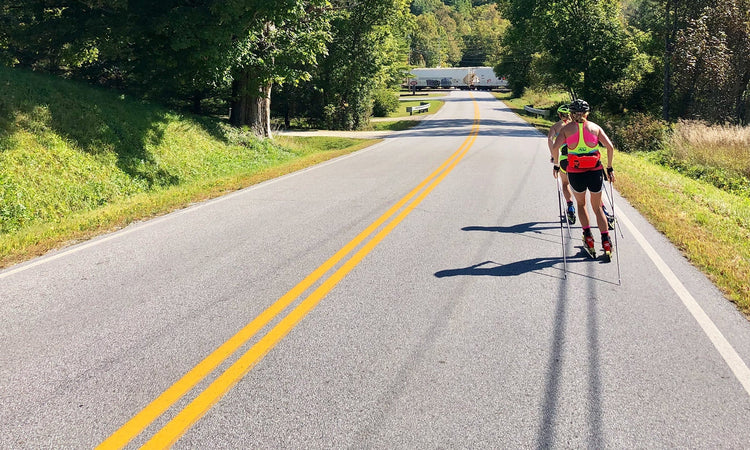All About Rollerskis: How to Choose and Use the Best Gear for Summer XC Training

All About Rollerskis: How to Choose and Use the Best Gear for Summer XC Training.
Rollerskiing is the go-to solution for summer cross-country ski training. While it’s not the only off-season option, it’s by far the most effective way to target the specific muscles used in skiing.
Rollerskis build not only specific ski strength in legs, core and upperbody but roller skiing, with focus, will improve ski technique, unlike running or other forms of cross training. Before buying rollerskis, decide which skiing style you want to focus on—skate or classic.
Skate rollerskis are shorter, the wheels are narrow and are designed for the side-to-side skate motion.
Classic rollerskis are longer, the wheels are wider and one wheel on each ski is ratcheted to simulate the diagonal stride grip.
Many skiers start with skate rollerskis because they mimic a wider range of skate ski techniques; v-1, v-2 and open field. Classic rollerskis have a ratcheted rear wheel that simulates grip, but if used incorrectly, can lead to bad habits—like kicking backward rather than applying proper downward force.
Eventually, committed skiers may want both styles of rollerskis. Although “combi” skis (both skate and classic) are available, the overly wide classic wheels, among other issues in the design, do not work for ski skating.
Wheel speed and shaft materials.
Wheel speed is dependent on the wheel bearings and the wheel rubber. Fast wheels mimic snow ski speed but are often difficult to control for many skiers. Most rollerskis are designed for pavement skiing. Bumps, cracks, small stones and wet leaves all pose navigational challenges to skiers.
The company V2 offers a pseudo ‘off-road’ rollerski equipped with wider tires and innertubes. This heavier but more stable set-up is attractive to master skiers who prioritize stability over speed and weight. These skis also offer a brake, usually connected to a skier’s leg. Young or serious skiers eschew this heavier wheel design because the weight of the rollerski slows down the ski skating motion.
Rollerski shafts come in aluminum, fiberglass or carbon fiber. Similar to bike frames-- the aluminum is durable but transmits road vibration. Fiberglass offers a good balance of flex and cost, making it a popular choice. Carbon fiber is the lightest, and most shock absorbing, but has a higher price tag.
Rollerskis typically don’t come with bindings. Current setups are based on the NNN platform. Make sure to get rollerski-specific bindings, which include an extra screw to prevent accidental release.
Additional Rollerski items.
- Boots
- Be sure to use the correct boots for the correct style of skis. Choose skate boots for skate rollerskis and classic boots for classic rollerskis. Soft combi boots don’t offer enough ankle support for skating. Proper boot stiffness, in the ankle and the sole, helps the skier confidently ski with good balance and weight transfer.
- Poles
- We suggest using a dedicated rollerski pole. Poles are easy to break due to incorrect pole placement, or on bridge crossings when the pole tip sticks between wooden slats. Poles shafts have a high probability of being nicked during dryland rollerskiing and could break unexpectedly during a crucial snow ski race.
Ideally, rollerski poles should be 2 cm or so higher than the skiers’ skate or classic snow poles. The skier uses skate poles for skate skiing (lip height) and classic poles (shoulder height) for striding. Poles should be stiff enough to withstand the body push when moving forward. A cheap pole will bend (or break) when used with force, affecting the dryland ski technique. - Roller ski tips
- Roller tips or ferrules should replace ski baskets on poles used for rollerskiing. These carbide tips must be kept sharp to catch on the asphalt pavement. (Rollerski tips do not work on cement roads or sidewalks).
- Gloves
- Lightweight, full-fingered, snug fitting gloves protect against blisters. Bike gloves may not offer enough coverage.
- Helmet
- Lastly wearing a protective bike helmet is a must. A helmet is non-negotiable. For additionally road safety, wear bright clothing or a reflective vest.
“Skiers are made in the summer”…
Rollerskiing is the only dryland method that truly builds both ski-specific strength and technique. It also offers a low-impact, weight bearing alternative for injured runners seeking to stay active.
Gear West offers rollerski clinics and rollerskis to demo throughout the summer. Additionally we are always available to answer questions.
Gear West Videos
How to Stop on rollerskis
Custom Insoles



